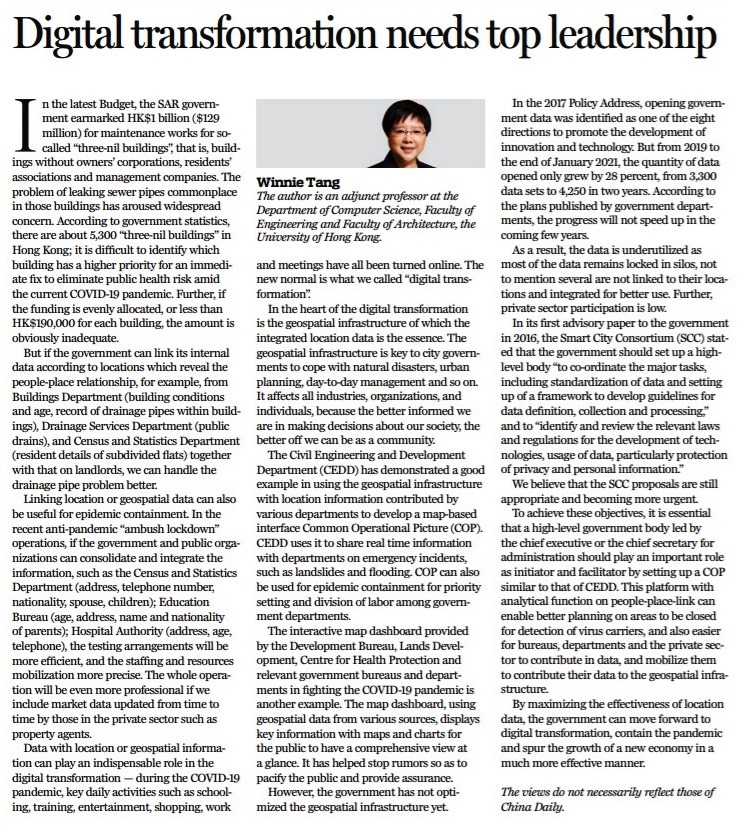網上版請按此

Digital transformation needs top leadership
In the latest Budget, the SAR government earmarked HK$1 billion ($129 million) for maintenance works for so-called "three-nil buildings", that is, buildings without owners' corporations, residents' associations and management companies. The problem of leaking sewer pipes commonplace in those buildings has aroused widespread concern. According to government statistics, there are about 5,300 "three-nil buildings" in Hong Kong; it is difficult to identify which building has a higher priority for an immediate fix to eliminate public health risk amid the current COVID-19 pandemic. Further, if the funding is evenly allocated, or less than HK$190,000 for each building, the amount is obviously inadequate.
But if the government can link its internal data according to locations which reveal the people-place relationship, for example, from Buildings Department (building conditions and age, record of drainage pipes within buildings), Drainage Services Department (public drains), and Census and Statistics Department (resident details of subdivided flats) together with that on landlords, we can handle the drainage pipe problem better.
Linking location or geospatial data can also be useful for epidemic containment. In the recent anti-pandemic "ambush lockdown" operations, if the government and public organizations can consolidate and integrate the information, such as the Census and Statistics Department (address, telephone number, nationality, spouse, children); Education Bureau (age, address, name and nationality of parents); Hospital Authority (address, age, telephone), the testing arrangements will be more efficient, and the staffing and resources mobilization more precise. The whole operation will be even more professional if we include market data updated from time to time by those in the private sector such as property agents.
Data with location or geospatial information can play an indispensable role in the digital transformation — during the COVID-19 pandemic, key daily activities such as schooling, training, entertainment, shopping, work and meetings have all been turned online. The new normal is what we called "digital transformation".
In the heart of the digital transformation is the geospatial infrastructure of which the integrated location data is the essence. The geospatial infrastructure is key to city governments to cope with natural disasters, urban planning, day-to-day management and so on. It affects all industries, organizations, and individuals, because the better informed we are in making decisions about our society, the better off we can be as a community.
The Civil Engineering and Development Department (CEDD) has demonstrated a good example in using the geospatial infrastructure with location information contributed by various departments to develop a map-based interface Common Operational Picture (COP). CEDD uses it to share real time information with departments on emergency incidents, such as landslides and flooding. COP can also be used for epidemic containment for priority setting and division of labor among government departments.
The interactive map dashboard provided by the Development Bureau, Lands Development, Centre for Health Protection and relevant government bureaus and departments in fighting the COVID-19 pandemic is another example. The map dashboard, using geospatial data from various sources, displays key information with maps and charts for the public to have a comprehensive view at a glance. It has helped stop rumors so as to pacify the public and provide assurance.
However, the government has not optimized the geospatial infrastructure yet.
In the 2017 Policy Address, opening government data was identified as one of the eight directions to promote the development of innovation and technology. But from 2019 to the end of January 2021, the quantity of data opened only grew by 28 percent, from 3,300 data sets to 4,250 in two years. According to the plans published by government departments, the progress will not speed up in the coming few years.
As a result, the data is underutilized as most of the data remains locked in silos, not to mention several are not linked to their locations and integrated for better use. Further, private sector participation is low.
In its first advisory paper to the government in 2016, the Smart City Consortium (SCC) stated that the government should set up a high-level body "to co-ordinate the major tasks, including standardization of data and setting up of a framework to develop guidelines for data definition, collection and processing," and to "identify and review the relevant laws and regulations for the development of technologies, usage of data, particularly protection of privacy and personal information."
We believe that the SCC proposals are still appropriate and becoming more urgent.
To achieve these objectives, it is essential that a high-level government body led by the chief executive or the chief secretary for administration should play an important role as initiator and facilitator by setting up a COP similar to that of CEDD. This platform with analytical function on people-place-link can enable better planning on areas to be closed for detection of virus carriers, and also easier for bureaus, departments and the private sector to contribute in data, and mobilize them to contribute their data to the geospatial infrastructure.
By maximizing the effectiveness of location data, the government can move forward to digital transformation, contain the pandemic and spur the growth of a new economy in a much more effective manner.
The views do not necessarily reflect those of China Daily.
Dr. Winnie Tang
Adjunct Professor, Department of Computer Science, Faculty of Engineering; Department of Geography, Faculty of Social Sciences; and Faculty of Architecture, The University of Hong Kong